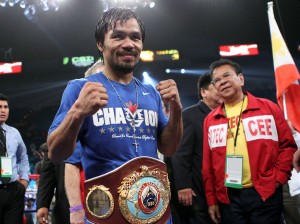
Fight fans, an endangered species, will applaud if Golden Boy Promotions does not match Top Rank’s offer to Juan Manuel Marquez, thereby ensuring a Marquez-Manny Pacquiao trilogy. For Pacquiao, it makes sense, which is another way of saying that Floyd Mayweather Jr. never does. It’s also fair to Marquez, whose draw and controversial loss by split decision in two bouts with Pacquiao provide him claiming rights on a third shot at the Filipino Congressman
But this is boxing, which is to say that common sense and fair play are about as endangered as those fans. CBS/Showtime is interested only in the potential numbers. Before Paquiao’s one-sided decision over Shane Mosley, they looked promising. In the aftermath, not so much.
The fine print in sportscaster James Brown’s apology for pre-fight hype about a rejuvenated Mosley has to include a warning that the network won’t be so quick to buy into any Pacquiao opponent other than Mayweather.
That pretty much leaves the business exactly where it was before Bob Arum dumped HBO and pay-per-view’s gilded cage for what Arum calls terrestrial television. Whatever it is, it’s still subterranean for boxing.
Marquez, a consummate pro, is well-known in Mexico. Yet his popularity lags behind emerging star Saul “Canelo” Alvarez and Julio Cesar Chavez, Jr, the crown prince of Mexican boxing. Marquez has neither Alvarez’ red hair nor Chavez’ legendary name. He only fights with a style that has given Pacquiao fits. But ask the so-called casual U.S. fan about him and they’re likely to answer with a question: Juan Manuel Who?
During the week before Mosley failed to deliver on the promised drama at Las Vegas MGM Grand, there were sources close to Pacquiao who said Marquez worried the Filipino more than any fighter. For Pacquiao, Marquez might be what Ken Norton was to Muhammad Ali. There’s always somebody out there who can beat you. In Marquez, Pacquiao has an opponent who specializes in counter-punching and has figured out how to time his counters with uncanny precision.
A couple of days before opening bell last Saturday, Mosley trainer Naazim Richardson said he had detected a vulnerability in a Pacquiao assault that includes a high volume of punches from unusual angles. The secret might be in the geometry. If there is form or function or repetition to any one of Pacquiao’s angles, there might be an opportunity to time a counter. Richardson could have seen it, but Mosley couldn’t capitalize because he lacked either the will or had lost the ability or a combination of both.
Perhaps, Marquez and trainer Nacho Beristain saw the flaw before Richardson or anyone else. They were able to implement an effective counter when Marquez was younger and fighting Pacquiao at a lighter weight, first at 126 pounds in 2004 and again at 130 in 2008. But youth and weight are the issues.
If Golden Boy passes on the right to match Top Rank’s offer, Marquez-Pacquiao III is projected for Nov. 12, or more than three months after Marquez turns 38. If a bigger Mosley at 39 had no chance against Pacquiao, it’s fair to wonder whether a smaller Marquez at 38 would fare much better.
Then there’s the weight, potentially a bigger issue. The agreement calls for a fight at 144 pounds. It’s called a catch weight, but it could be a gotcha clause.
Pacquiao, who has the legs of a middleweight, has become more and more comfortable at 140-plus pounds since he moved up the scale for his stunning stoppage of Oscar De La Hoya in 2008. He was at 142 for De La Hoya, 144 ½ for Antonio Margarito, 145 ¾ for Joshua Clottey, 144 for Miguel Cotto and 145 for Mosley.
Compare that to Marquez, whose experience at more than 140 pounds is limited to Floyd Mayweather Jr. in September 2009. That’s when the Mexican was 142 pounds and looked about as mobile as a 1965 Chevy, stripped of its tires and left to rust on cinder blocks. Marquez’ one-sided loss by decision to Mayweather was as devoid of drama as Mosley’s weary walkabout against Pacquiao.
A fight? Maybe.
Yeah, Marquez could make it a good one.
But the toughest fight figures to be the sales pitch.
Back at home
Jose Benavidez Jr. was the featured attraction Wednesday at a news conference for his pro debut in his hometown, Phoenix, on June 11 at Wild Horse Casino in suburban Chandler. Arizona’s immigration controversy has kept Benavidez on the road since Top Rank signed him as a 17 year-old.
“It’s been like three years since I fought in front of family and friends,’’ said Benavidez, who is 12-0 as a junior-welterweight after a fifth-round stoppage of James Hope on the Pacquiao-Mosley undercard.
Benavidez’ long-awaited homecoming represents a second stage in his development. It’s a chance for him to create a hometown identity. For the last couple of years, he’s been a fighter without one, although he has been wearing Phoenix on his waistband of his trunk since he turned pro.
Benavidez, who will be 19 when he makes his homecoming, says he still has a lot to learn. On the Pacquiao-Mosley undercard, he sometimes stood too upright, although his jab continued to work with punishing proficiency. The lanky, athletic Benavidez often looks as if he has some of the same physical components of the late Diego Corrales.
“He was my favorite fighter,’’ said Benavidez, who was kid when he saw Corrales for the first time in a loss to Mayweather. “It’s just an honor to even hear my name mentioned in any comparison to Corrales.’’
Notes, Quotes
• Bernard Hopkins has never been afraid to throw race into the argument. But a slur directed at former Eagles quarterback Donovan McNabb, now of the Redskins, is offensive. Hopkins attacked McNabb’s upbringing in suburban Chicago. “He’s got a suntan, that’s all,’’ Hopkins told reporters at his Philadelphia gym while selling his May 21 rematch with Jean Pascal in Montreal. I guess that means Hopkins must not think much of Barack Obama either. President Obama grew up privileged in Honolulu where he went to Punahou, an expensive, predominantly-white prep school. Hopkins’ slur reminds me of Fernando Vargas, who insulted De La Hoya’s roots by saying he failed to fight with the courage of a true Mexican. Ridiculous.
• Andre Ward, who might become a potential Hopkins opponent if he wins the Super Six tournament, figures to beat Arthur Abraham in the 168-pound semifinal in Carson, Calif., in a Showtime-televised bout. Ward likes to say he stays motivated by slights, real or imagined. There might some unspoken motivation for him against Abraham, who hurt his friend and 2004 Olympic teammate, Andrew Dirrell, in March 2010. That’s when Abraham hit and hurt Dirrell when Dirrell was down. Dirrell, who won the bout via disqualification, hasn’t fought since.
• And here’s another fight I guess we’ll never see because of the Top Rank-Golden Boy feud: Heavyweight and former Michigan State linebacker Seth Mitchell against Baltimore Ravens safety and former North Dame star Tommy Zbikowski. Zbikowski is a Top Rank fighter. Mitchell, scheduled for a bout Friday night against Evans Quinn in Primm, Nev., is with Golden Boy. Zbikowski-Mitchell would be a natural on the night before a Michigan State-Notre Dame game.
Photo by Chris Farina / Top Rank









